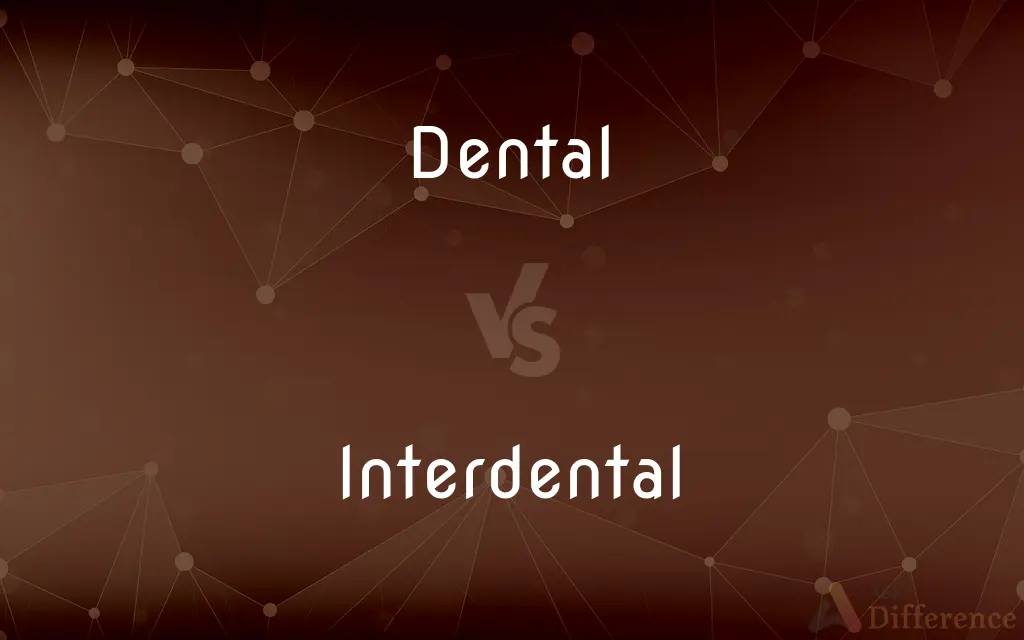Dental vs. Interdental — What's the Difference?
Edited by Tayyaba Rehman — By Urooj Arif — Updated on April 6, 2024
Dental sounds involve the tongue touching the teeth, while interdental sounds are made by placing the tongue between the teeth.

Difference Between Dental and Interdental
Table of Contents
ADVERTISEMENT
Key Differences
Dental sounds are articulated with the tongue against the teeth, as found in languages like English and Spanish. These sounds include consonants like /t/, /d/, and /n/, where the tongue makes contact with the upper teeth. They are key in distinguishing words and their meanings in many languages. Interdental sounds, on the other hand, require the tongue to be placed between the teeth. English th-sounds, as in "think" and "that," are prime examples.
While dental sounds are prominent in many languages and considered somewhat easier to produce because of the direct contact between the tongue and the teeth, interdental sounds are characterized by the airflow being directed through the teeth, producing a distinctive fricative quality. This difference in articulation affects the sound's acoustics and perception.
The presence of dental consonants across various language families underscores their linguistic importance. Interdental sounds, despite their rarity, add a layer of phonetic diversity to the languages that employ them. Their unique articulation can serve as a linguistic marker, distinguishing languages and dialects that feature these sounds prominently, such as the distinction between the standard American and British English pronunciations of "think."
Dentals are essential for creating minimal pairs words that differ in only one phonological element contributing to the richness of a language's phonetic inventor. Interdental sounds are less common globally and can be more challenging for non-native speakers to master due to their unique articulation.
Comparison Chart
Articulation
Tongue touches the teeth
Tongue protrudes between the teeth
ADVERTISEMENT
Sounds
/t/, /d/, /n/, and more
English "th" sounds (/θ/, /ð/)
Commonality
Common in many languages
Less common, more specific to certain languages
Production
Easier for most speakers
Can be challenging for non-native speakers
Examples
Spanish "d" in "lado"
English "th" in "think"
Compare with Definitions
Dental
Consonants articulated with the tongue against the teeth.
In the word dentist, the initial d is a dental consonant.
Interdental
Characteristic of English and a few other languages.
Thistle showcases the unique interdental fricative of English.
Dental
Includes sounds like /t/, /d/, and /n/.
The word tadpole starts with a dental consonant.
Interdental
Sounds made with the tongue placed between the teeth.
The th in think is an interdental sound.
Dental
Common in languages worldwide.
Many languages have dental sounds, making them familiar to a wide audience.
Interdental
Requires specific tongue positioning beyond the teeth.
Producing the sound in theater involves pushing your tongue between your teeth.
Dental
Produced by direct contact between the tongue and the teeth.
To say door, your tongue briefly touches your upper teeth.
Interdental
Includes the sounds /θ/ and /ð/.
That contains a voiced interdental fricative.
Dental
Found in both voiced and voiceless forms.
Dental starts with a voiced dental consonant, while tenth contains a voiceless one.
Interdental
Can be challenging for speakers of languages without these sounds.
Non-native English speakers often find think and this difficult to pronounce correctly.
Dental
Of, relating to, or for the teeth
Dental caps.
Interdental
Located or made for use between the teeth.
Dental
Of, relating to, or intended for dentistry
Dental work.
Dental bills.
Interdental
Pronounced with the tip of the tongue between the teeth, as (th) in that or (th) in thumb.
Dental
(Linguistics) Articulated with the tip of the tongue near or against the upper front teeth
The English dental consonants t and d.
Interdental
An interdental consonant.
Dental
A dental consonant.
Interdental
Pertaining to the space between the teeth.
It is recommended to use an interdental brush, or dental floss, to clean between the teeth.
Dental
(relational) Of or concerning the teeth.
Dental care
Interdental
(phonetics) Pronounced with the tongue between the top and bottom teeth.
Dental
Of or concerning dentistry.
Interdental
(phonetics) A speech sound pronounced with the tongue between the top and bottom teeth.
Dental
(phonetics) Made with the tip of the tongue touching the upper front teeth or the alveolar ridge.
Dental fricative
Interdental
(dentistry) A small toothbrush for cleaning in between adjacent teeth.
Dental
(veterinary medicine) Cleaning and polishing of an animal's teeth.
Interdental
Situated between teeth; as, an interdental space, the space between two teeth in a gear wheel.
Dental
(phonetics) A dental sound.
Interdental
Formed between the upper and lower teeth; as, interdental consonants.
Dental
Of or pertaining to the teeth or to dentistry; as, dental surgery.
Dental
Formed by the aid of the teeth; - said of certain articulations and the letters representing them; as, d and t are dental letters.
Dental
An articulation or letter formed by the aid of the teeth.
Dental
A marine mollusk of the genus Dentalium, with a curved conical shell resembling a tooth. See Dentalium.
Dental
Of or relating to the teeth;
Dental floss
Dental
Of or relating to dentistry;
Dental student
Common Curiosities
Can interdental sounds be found in all languages?
No, interdental sounds are less common and typically found in languages like English.
What is an example of a dental sound in English?
The initial sound in "door" is a dental consonant.
What are dental sounds?
Dental sounds are consonants produced with the tongue touching the upper teeth, common in many languages.
What makes interdental sounds unique?
Their articulation, requiring the tongue to be placed between the teeth, sets them apart from other sound types.
Why might non-native speakers struggle with interdental sounds?
Lack of these sounds in their native language makes them challenging to learn and pronounce.
Do all dialects of English use interdental sounds?
While prevalent, some dialects may replace them with dental or alveolar sounds.
How do interdental sounds affect language learning?
They can pose pronunciation challenges for learners, especially in languages where these sounds are critical.
How do speakers produce the "th" sound in English?
By pushing the tongue between the upper and lower teeth and blowing air out.
Are dental sounds easier to pronounce than interdental sounds?
Yes, for many speakers, dental sounds are easier to produce due to the more straightforward tongue-teeth contact.
Can interdental and dental sounds change a word's meaning?
Yes, in languages that use both, the sounds can lead to minimal pairs, altering meanings.
Is it common for languages to have both dental and interdental sounds?
Some languages, like English, have both, but many others have one or neither.
How are interdental sounds produced?
Interdental sounds are made by placing the tongue between the teeth, creating a unique fricative quality.
Are there any languages without dental sounds?
Most languages have dental sounds due to their ease of articulation and phonetic versatility.
How do dental and interdental sounds contribute to phonetic diversity?
They enrich a language's sound system, offering nuanced ways to form words and meanings.
What is a minimal pair involving dental sounds?
"Tad" and "dad" differ only in their initial dental consonant, making them a minimal pair.
Share Your Discovery

Previous Comparison
Helpless vs. Hopeless
Next Comparison
Dim vs. DullAuthor Spotlight
Written by
Urooj ArifUrooj is a skilled content writer at Ask Difference, known for her exceptional ability to simplify complex topics into engaging and informative content. With a passion for research and a flair for clear, concise writing, she consistently delivers articles that resonate with our diverse audience.
Edited by
Tayyaba RehmanTayyaba Rehman is a distinguished writer, currently serving as a primary contributor to askdifference.com. As a researcher in semantics and etymology, Tayyaba's passion for the complexity of languages and their distinctions has found a perfect home on the platform. Tayyaba delves into the intricacies of language, distinguishing between commonly confused words and phrases, thereby providing clarity for readers worldwide.













































